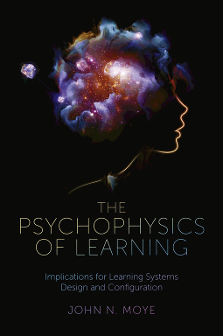
Prelims
ISBN: 978-1-80117-114-4, eISBN: 978-1-80117-113-7
Publication date: 22 June 2021
Citation
Moye, J.N. (2021), "Prelims", The Psychophysics of Learning, Emerald Publishing Limited, Leeds, pp. i-ix. https://doi.org/10.1108/978-1-80117-113-720211011
Publisher
:Emerald Publishing Limited
Copyright © 2021 John N. Moye. Published under exclusive licence by Emerald Publishing Limited
Half Title Page
The Psychophysics of Learning
Title Page
The Psychophysics of Learning: Implications for Learning Systems Design and Configuration
By
John N. Moye
Performance Learning Technologies, USA

United Kingdom – North America – Japan – India – Malaysia – China
Copyright Page
Emerald Publishing Limited
Howard House, Wagon Lane, Bingley BD16 1WA, UK
First edition 2021
Copyright © 2021 John N. Moye
Published under exclusive licence by Emerald Publishing Limited
Reprints and permissions service
Contact: permissions@emeraldinsight.com
No part of this book may be reproduced, stored in a retrieval system, transmitted in any form or by any means electronic, mechanical, photocopying, recording or otherwise without either the prior written permission of the publisher or a licence permitting restricted copying issued in the UK by The Copyright Licensing Agency and in the USA by The Copyright Clearance Center. Any opinions expressed in the chapters are those of the authors. Whilst Emerald makes every effort to ensure the quality and accuracy of its content, Emerald makes no representation implied or otherwise, as to the chapters' suitability and application and disclaims any warranties, express or implied, to their use.
British Library Cataloguing in Publication Data
A catalogue record for this book is available from the British Library
ISBN: 978-1-80117-114-4 (Print)
ISBN: 978-1-80117-113-7 (Online)
ISBN: 978-1-80117-115-1 (Epub)


List of Figures and Tables
| Figure 3.1. | The Sensation of Sound. |
| Figure 3.2. | The Sensation of Touch. |
| Figure 3.3. | The Sensation of Smell. |
| Figure 3.4. | Population Encoding of Smell. |
| Figure 3.5. | The Sensation of Taste. |
| Figure 3.6. | The Population Encoding of Taste. |
| Figure 3.7. | The Sensation of Vision. |
| Figure 4.1. | Perception of Sound. |
| Figure 4.2. | Perception of Touch. |
| Figure 4.3. | Perception of Smell. |
| Figure 4.4. | Perception of Taste. |
| Figure 4.5. | Perception of Vision. |
| Figure 5.1. | Cognition of Sound. |
| Figure 5.2. | Cognition of Touch. |
| Figure 5.3. | Cognition of Smell. |
| Figure 5.4. | Cognition of Taste. |
| Figure 5.5. | Cognition of Vision. |
| Figure 6.1. | Learning Engagement Conceptual Framework. |
| Figure 6.2. | Discipline-Specific Learning Objects. |
| Figure 7.1. | Designing the Learning Experience. |
| Figure 8.1. | Designing the Environmental Learning Dimension. |
| Table 1.1. | The Systems of Psychophysical Learning. |
| Table 6.1. | Equivalencies of Psychophysics of Sensation and Learning Engagement. |
| Table 7.1. | Attributes of Perception and the Equivalent Learning Experience Implications. |
| Table 7.2. | Psychophysical Learning Experience Design Framework. |
| Table 8.1. | Translating Sensory Cognition into Learning Environment Dimension. |
Abstract
Learning is an inherently neurological process that involves receiving, processing, and making sense of external information. Neurologically, these are the processes of sensation, perception, and cognition and the psychophysics of these phenomena provide insight into the methods and techniques the brain uses to engage with, process, and internalize the meaning of new information to each individual.
This work collects and codifies the psychophysical research for each sense. These research findings are used to create design frameworks for the learning engagement, learning experience, and learning environment, which creates a psychophysical model of learning that simulates the natural processes the brain uses to learn from external stimuli. These design models are translated into practical approaches to curriculum, instruction, and experience design strategies, which promote and enhance learning outcomes for all learners. As a result, learner access to information, consonance with learning processes, and internalization of the learning are aligned with the information processes strategies of the brain.
Keywords: Learning; psychophysics; learning engagement; learning experience; learning environment; learning access; information processing; curriculum design; instructional design; learning ecology; collective learning; implicate order; learning alignment; social integration; diverse learning processes; sensation; perception; cognition; interconnectedness; interaction
- Prelims
- Chapter 1 Purpose and Intent
- Chapter 2 Overview of the Relevance of Psychophysics to Learning
- Chapter 3 The Psychophysics of Sensation
- Chapter 4 The Psychophysics of Perception
- Chapter 5 The Psychophysics of Cognition
- Chapter 6 Learning Engagement
- Chapter 7 Learning Experience
- Chapter 8 Learning Environment
- Chapter 9 A Psychophysical Learning System
- References
- Index